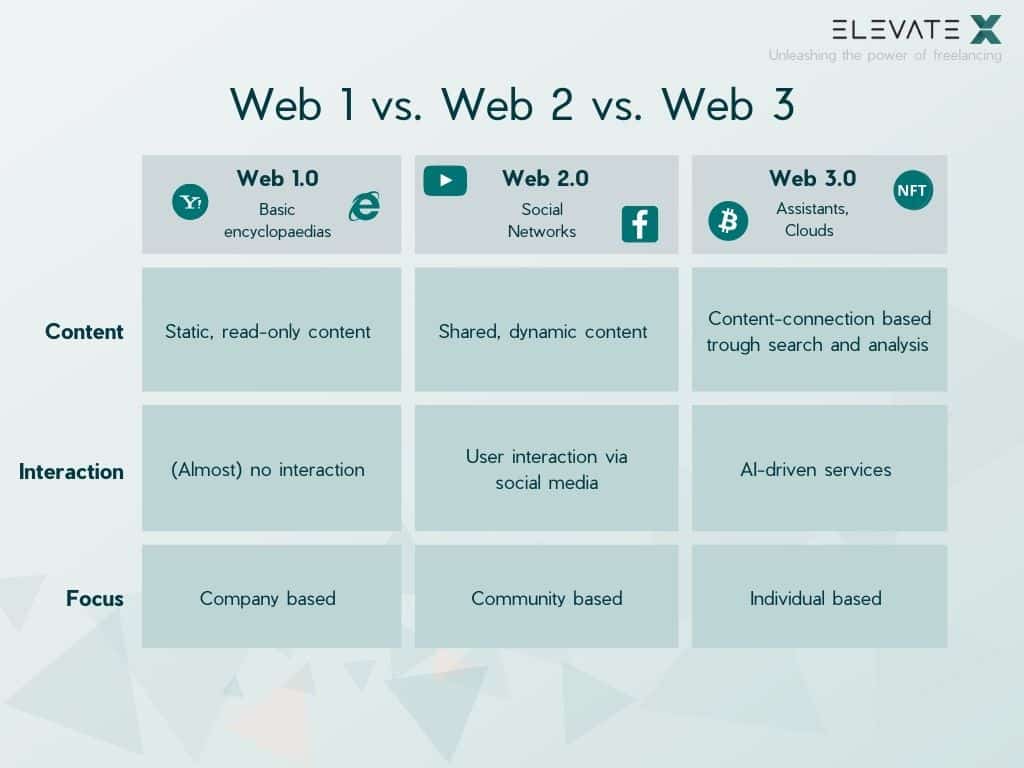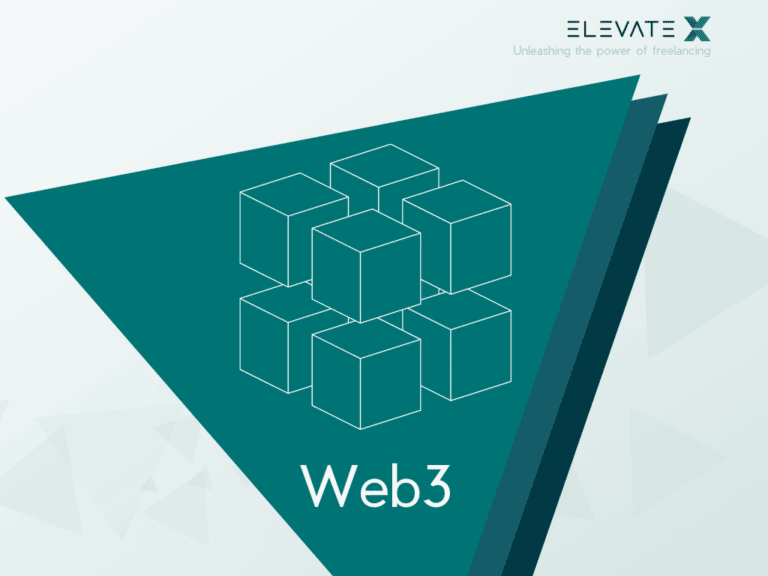Web 1, Web2 and Web3. For a few years now, the internet is evolving from the web we used to know. “Web3” is becoming more relevant and the logical step in development after Web1 and the current Web2. Where are the differences?
To understand Web3, there is to clarify the first two stages of web.

What is Web1?
Web1 Technologies includes core web protocols: HTML, HTTP and URI. The major characteristics of Web1 are:
- They have read-only content; the use of the web was just to gain information from texts on static pages.
- Online presence and providing information to anyone at any time.
- It includes static web pages without user interaction.
A good example of the webpage-structure in that time is Yahoo GeoCities.
This famous web-web website hosting carrier become lively with inside the U.S. from 1994-09. It hosted a huge number of private websites at its peak. And became the primary giant “social network” and one of the most visited webpages on the globe. It was shut down in 2009, but luckily a few examples of that time were captured for the future.
Around 2000, the technical possibilities weren’t as near as developed to what we are used now. This was visually clear by the website-structure and the interaction potential:
- The Web1 pages can only be understood by humans and don’t have an option to give feedback, no comments or quotes.
- The webmaster is the one responsible for updating users and managing the content of the website.

Basically, the main players are businesses and companies. Think of it as a giant encyclopaedia without many visuals, controls, forms, and interactivity. One of the first browsers was the Navigator from a company called Netscape. It had over 90 percent of market share and guided many users to whatever they were searching for on the web. With the rise of the free Internet Explorer to all Microsoft Windows PCs, it slowly vanished. Netscape remained an open community and later started the Mozilla project, which resulted in the Firefox Browser.
What is Web2?
After 2004, the percentage of published content shifted to more and more user-generated content, because the internet became vastly popular. The evolution of social media has been favored by the human impulse to communicate and by advances in digital technology. It is a story about establishing and nurturing personal connections at scale.
Social Media
MySpace (2003), Facebook (2005) and Twitter (2006) as long a lot of smaller social media platforms were founded in that time – and highly successful. Shortly after their launches, millions of users interacted. Founded in 2005, YouTube realized quickly, that partnering with content creators would bring a massive amount in not only the content itself, but a big revenue in marketing and ads.

Blogs
While other platforms have been founded by Harvard or Stanford graduates, one of the first microblogging websites, was created by 17-year-old David Karp: Tumblr. It allows users to post small texts, images and interact via “tumbleblogs”. Later the term microblogging was described as “exchange small elements of content such as short sentences, individual images, or video links.”
For more captivating stories, you might check out our own Blog.
Podcasts
Speaking of blogs, podcast used to be called “audio blogs”. Later, with access to broadband Internet access and portable digital audio playback devices such as the iPod, podcasting was easier and more comfortable.
Messenger
MSN, ICQ and AOL Instant Messenger laid the foundation of modern messaging. The implementation of emojis in the early 2000s also set a new era and influenced the communication of a whole generation.
Generally, users are increasingly more relevant, and the web is flooded with content and interaction. Especially the using of the web for communication, precisely with portable devices, implements the term of a Social Web.
What is Web3?
Whereas in Web2 it was important for users to generate their own content, in Web3 the emphasis is now on providing user-generated information with a description that is unambiguous in its meaning. Users are creating applications through which other users can interact and publish content.
While the Web2 focused on users generating their own content, Web3 now focuses on providing user-generated information with a description that is unique in meaning. Users create applications through which other users can interact and publish content.
Unlike the evolution of Web1 to Web2, the change to Web3 largely affects the back end. Thus, it is primarily the processes in the background that change, while little changes in the user interface itself.
For example, the content of Web3 will become more relevant because it is based on the analysis of user data. In addition, the use of AI services is made possible, and the focus is less on the totality and more on individual users themselves.

Decentralization
Because of its decentralization structure based on the blockchain technology, Web3 is widely considered to be more secure. A decentralized net is based on a peer-to-peer community constructed upon a network of users. This group’s personal internet-linked gadgets could host websites or applications, instead of a set of high-powered servers. Every internet site or utility receives allotted throughout loads of nodes placed on one-of-a-kind gadgets.
Multi-User-Environment
Multiuser surroundings are one wherein different customer can join and adjust the equal database which you are running with. As a result, numerous customers are probably running with the equal database items on the equal time. Thus, introduce the opportunity of the database being tormented by adjustments made via way of means of different customers at the same time as you’re adjusting, and vice versa.
Ultimately, it’s possible to simultaneously edit a document, a database, a table etc.
There are near endless possibilities for the future web, and it’s already noticeable with the rising importance of cryptocurrency, NFTs, and cybersecurity.
Web3 helps to cope with this flood of information. Now, computers can largely only manage and pass on data, but cannot interpret it or put it in context with other data. Web3 helps to restructure information and make relevant information identifiable.
What Are The Differences Between Web1, Web2 and Web3?
Web1 was the first stage of the Internet and dates back to the 1980s. This phase was characterized by simple static web pages that consisted only of text and did not offer interactivity. The web was mainly a medium for transmitting information, but there was no way to actively participate in content creation. The technology was not yet as advanced, and there were only a limited number of users.
Web2 was introduced in the late 1990s and is still the most commonly used stage of the Internet today. Unlike Web1, Web2 websites were dynamic and interactive, offering users a wide range of options to create and share content. Social media platforms such as Facebook, Twitter, and Instagram were born in this phase, and new technologies such as cloud computing and artificial intelligence emerged. The web became an interactive medium in which users were actively involved in content creation.
Web3 is the next stage of Internet development and is also known as “the decentralized web”. It is still relatively new and in the development phase, but it promises to fundamentally change the web. The decentralized web is supported by blockchain technology and cryptocurrencies, providing users with more control over their data and content. Instead of users handing over their data to centralized platforms like Facebook and Google, they will be able to store and manage their own data. Web3 is also expected to enable the creation of new decentralized applications by users.
What Are The Similarities Between Web1, Web2 And Web3?
Upon careful examination of the three distinct versions of the web, it becomes apparent that they share only a handful of fundamental characteristics. These commonalities include their focus on the relationship between end-users and information, their provision of a version of the “read” function for users, and their reliance on the Internet to carry out their tasks.
What Are The Features Of Web1, Web2 And Web3?
Here are the main features of each web version:
Web1:
- No communication between users and servers
- Static websites where only the content can be viewed
- Hyperlinks and bookmarks for pages
- Read-only Web
Web2:
- Improved user interaction over Web 1.0
- Introduction of web applications
- Online document and video streaming capabilities
- Information and applications stored on servers
- Interactive advertising and pay-per-click
- Cloud computing operations
- Centralized data
- Web reading and writing
Web3:
- Intelligent, web-based functionality and applications
- Decentralized processes
- Fusion of web technology and knowledge representation
- Behavioral advertising and engagement
- Edge computing
- Live video
- Internet of Things (IoT)
- Semantic search
- Web read, write and control
Key Takeaways
Web1 was read-only pages.
Web2 introduced the social platforms. Interaction between users rose, dynamic content was created.
Web3 is all about ownership. Tokens, currencies, and shares of companies makes you a trading part of the web. Blockchain technology is the foundation tech, on which many applications in Web3 are running on. Although the big social media companies aren’t the main players in Web3, Facebook, for instance, is trying its best to form its own future internet by creating the Metaverse.
You are looking for a suitable developer to realize your project on the web? You can find more information here.
FAQs
In contrast to the development of Web1, to Web2, the change to Web3 largely affects the backend. Thus, it is primarily the processes in the background that change, while there is little change in the user interface itself.
The content of Web3, for example, becomes more relevant because it is based on the analysis of user data. In addition, the use of AI services is made possible, and the focus is less on the aggregate and more on individual users themselves.
The Web3 is all about property such as tokens, currencies and company shares, makes the user an acting part of the web. Blockchain technology is the foundation on which many applications in Web3 run. Although the big social media companies are not the main players in Web3, Facebook is trying to shape its own future Internet. For example, by creating the Metaverse.
Because of its decentralized structure based on blockchain technology, the Web3 is widely considered more secure. The personal, Internet-connected devices of this group could host websites or applications, rather than a series of high-performance servers.
The possibilities for the web of the future are almost limitless, and the rising importance of cryptocurrencies, NFTs, and cybersecurity is already being felt.








